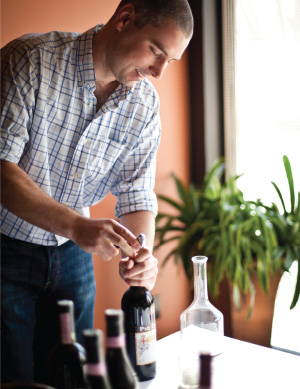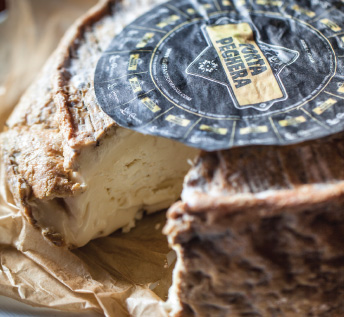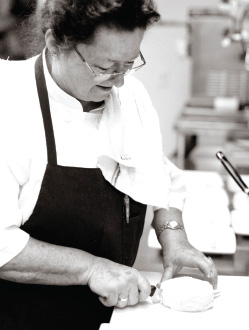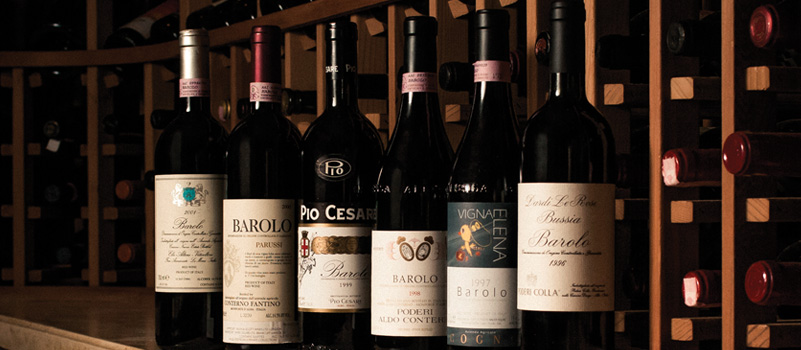Castelmagno d’Alpeggio is a curious cheese. It’s made in Castelmagno, a municipality in the hills of western Piemonte, 15 miles from the French border and about 40 miles southwest of Barolo. The curds (made from a blend of cow, ewe and goat milk) are repeatedly salted and milled into small pieces before aging. Then, as each round ages, cheese mites work away at the rind, leaving behind an earthy, powdery residue, and setting into motion a complex microbial chain of events that culminates in an intense, salty, crumbly cheese with somewhat austere flavors of chamomile and dried herbs.
Suzette Gresham, the executive chef at San Francisco’s Acquerello, was upset the first time she cut into a wheel of Castelmagno d’Alpeggio and found veins of dark blue mold at the center. But when Gresham complained to the vendor about the mold, he laughed: She’d actually hit the jackpot. In Piemonte, cheese mongers treasure wheels of Castelmagno d’Alpeggio that turn blue. (The producer of her current cheese, in fact, deliberately places molding bread in the cave next to the cheese to encourage this process.) So it was with pride and excitement this time that she presented us a slice clearly marbled with blue.
Her enthusiasm for the region’s cheeses, in particular, is positively giddy: “My favorite things on the face of the earth,” she says, opening one of her four three-ring binders stuffed with information on every cheese she’s ever purchased for the restaurant. Her copy of Slow Food Editore’s Italian Cheese is also well worn.
To show off her ever-changing selection, waiters wheel a cheese cart through the small dining room several times nightly. “It makes a distinct impression,” says wine director Gianpaolo Paterlini, Giancarlo’s son. Gianpaolo worked as a sommelier with the Michael Mina Group before returning to his home turf in 2007, and he’s since expanded Acquerello’s wine program into something exceptional. If you want your pick of old Barolos and Barbarescos, this is the place.
And since there’s often Barolo on the table when the cheese cart comes around, Paterlini has become something of an expert on pairing red wines with cheeses. This sounds potentially challenging, given the current widely held belief in the superiority of white wine with cheese. Paterlini doesn’t find it so. He agreed to pull a number of Barolos to prove his point, and we opened a few from the W&S cellar while Gresham plundered her cheese cave. Here’s what we learned in an afternoon of tasting and talking, exploring Piemonte through wine and cheese.


“I don’t think you can focus on flavor with Barolo and cheese,” Paterlini cautions, as we dig into the Castelmagno. “It’s all about the wine’s acidity and tannin and texture,” he says, and how those factors relate to the texture of the cheeses. The Castelmagno turns out to be a case in point: Its rough, grainy texture does nothing for the older wines on the table, with their fine, lightly gritty textures, but instead shines in contrast to the juiciness of the fruit in the younger 2000 Conterno Fantino Parussi.
“The Conterno Fantino is the epitome of modernism to me,” Paterlini says. It’s plump and rosy, its ripeness bolstered by the warm vintage and time spent in barriques. He often serves Conterno Fantino to California-leaning wine drinkers who are interested in trying a Barolo. But this is the sort of pairing anyone would appreciate: The wine’s body juices up the dry, coarse grain of the cheese, and the cheese seems to neutralize the rasp of the wine’s wood tannins, propelling its delicious, exuberant fruit tones into the spotlight.
Interestingly, the trio of soft, creamy robiola-style cheeses that Gresham brought out—a Roccaverano, a Due Latte and an Il Nocciolo—are much harder to place with the wines. The Roccaverano, the only DOP cheese in all of Italy made entirely from goat milk, is challenging, the goaty tang making the wines feel shrill; the Due Latte, a mix of cow and sheep milk, is the most successful, with a soft, mushroomy paste that’s less acidic than the other two cheeses, and echoes the sotto bosco character of the older Barolos.
Match Intensity
Gresham snuck in one non-Piemontese cheese, Torta di Peghera, from neighboring Lombardy, simply because it was at peak ripeness. “Cheese can be like risotto,” she says, showing off a mottled wheel. “When it’s ready, nobody waits.” A rarity today even in its homeland, overshadowed by Taleggio, it’s a washed-rind cow’s milk cheese with a pastoral richness made complex with plenty of barnyard funk.
The younger, more modern wines overpower its complexity with their primary fruit and oak, while the subtler older wines are too shy. The 1999 Pio Cesare meets it in the middle: Its fruit tannins are still robust enough to hold up against the cheese’s bitter rind, while the cheese draws out a burst of blue fruit that we hadn’t sensed before.


“This is one of my absolute favorites,” Gresham says as she serves up a Cusie con Frutta al Grappa de Moscato, a blend of sheep and cow milk aged for a year before being topped with dried fruit and soused in muscat grappa. Tangy and nutty, yet shot through with muscat’s sweet spice, the Cusie isn’t the most obvious partner for a red wine.
The surprise? Something about its meltingly creamy texture and sweetness actually calls out to the older Barolo. The 1996 Poderi Colla and the 1997 Elvio Cogno feel graceful and elegant despite the decadence of the cheese, and brighter than on their own. It’s another match based on texture.
Find Some Testun al Barolo
Testun means “hard head” in Italian, Gresham explains, presenting Testun al Barolo coated in Barolo must, crunchy grape pips and all, a rough, inky carapace surrounding the cheese. Barolo with Barolo! “The classic Testun doesn’t come coated in Barolo,” she tells us, “but this version is kind of a standby for us here—it’s so voluptuous, like a savory dessert.” Despite its name, this Testun is firm but not particularly hard. It’s a sharp, creamy washed-rind cheese made from ewe and cow milk. The grape must on the exterior takes on a salty black-olive savor, while infusing the cheese with fruitiness.


In Sum: Go Young…Most of the Time
“Older Barolos are too subtle for strong cheeses; younger is better,” Paterlini observes. In the best matches, the cheese comes through clearly while also bringing out the wine’s fruit tones—if there’s no primary fruit left, it’s harder to strike a balance. What would he serve with older Barolo, something even more evolved than our adolescent 1996? “I hate to sound cliché, but truffles, especially white, and mushrooms, especially fresh porcini, are amazing with really old Barolo,” he says.
But don’t count out cheese completely. Gresham recalls serving the grappa-laced Cusie at a dinner with Barolo dating back to the 1930s. Something about the cheese’s supple texture and exotic perfume matched these venerable wines—amid a succession of Barolo-friendly courses, it proved, by popular consensus, to be the evening’s star pairing.


Cheeses
Robiola Due Latte
Robiola di Roccaverano DOP
Il Nocciolo
Castelmagno Alpeggio
Torta di Peghera
Cusie con Frutta al Grappa de Moscato
Testun al Barolo
Wines
Poderi Colla
1996 Barolo Bussia Dardi Le Rose
Elvio Cogno
1997 Barolo Vigna Elena
Poderi Aldo Conterno
1998 Barolo
Pio Cesare
1999 Barolo
Conterno Fantino
2000 Barolo Parussi
Elio Altare
2001 Barolo
This story was featured in W&S December 2013.
photos by Kelly Puelio
Longtime senior editor at Wine & Spirits magazine, Luke now works for the Stanford Technology Ventures Program.
This story appears in the print issue of December 2013.
Like what you read? Subscribe today.
















